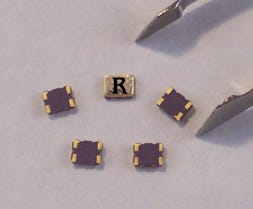April 3, 2012
Engineers have frequently faced a dilemma when considering frequency components for medical instrumentation and other applications. A nontemperature-compensated clock oscillator, for instance, carries an affordable price tag but is not capable of very tight temperature stability. In contrast, a temperature-compensated oscillator (TCXO) offers very tight stability, but at a significantly higher cost. Looking to fill this void, Ruby Quartz LLC (Aventura, FL) has introduced the compact COM2-series nontemperature-compensated clock oscillators that feature tight temperature stability at a price point comparable to that of conventional clock oscillators.
|
The compact COM2 nontemperature-compensated clock oscillator offers tight stability down to 10 PPM at an affordable price. |
Debuting on the market several years ago, the first generation of the COM-series clock oscillators were designed to offer the same temperature stabilities as competing clock oscillators in a significantly smaller footprint. But simple, nontemperature-compensated clock oscillators remained limited, only getting down as far as 20 parts per million (PPM) over a temperature range of approximately -40º to 85ºC, according to Sasha Wolloch, president of Ruby Quartz. If tighter stability was required, he notes, designers would often be forced to employ pricey TCXOs, which typically feature temperature stability of 2.5 PPM and tighter. "The traditional way would probably be to go for [stability performance] overkill with the TCXO and pay for it," Wolloch comments.
Using its compact COM oscillator technology as a building block, Ruby Quartz set out to address this gap in both price and stability performance for frequency components. "Through the usage of a special integrated circuit (IC) and some programming, we are able to reduce the overall stability down to 10 PPM," Wolloch states. "At a more affordable price, [the COM2] has a tighter temperature stability than with a traditional clock but is a bit looser than with a TCXO. And the price is also more [in line with] the price of a clock oscillator than with a TCXO." The company is touting the new technology as the first free-running, nontemperature-compensated clock oscillators with such a tight stability performance over an operating temperature range of -40º to 85ºC in a frequency range of 2.5 to 55 MHz.
Like its predecessor, the COM2 oscillator also boasts an ultracompact package that measures 5.0 × 3.3 mm. Available in high-speed CMOS technology, the oscillator has an operating voltage range of 1.8 to 5 V dc at a maximum of 7.0 mA, depending on the application's frequency and stability requirements. It is RoHS compliant as well.
"This product is ideal for applications in which the designer is concerned about finding the best compromise between price and performance, where a device has to be used at temperatures higher or lower than room temperature," Wolloch says.
You May Also Like



